The Hague School,
a set of articles from the Haag Gemeentemuseum at
www.gemeentemuseum.nl/
(search for “Mauve” )
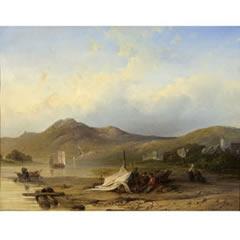 Romanticism
and the Hague School
Romanticism
and the Hague School
Publishing group VNU
recently donated the painting River Landscape (1842) by Willem
Roelofs to the Gemeentemuseum. This gift prompted the museum to
organize an exhibition of early works by several
painters from the Hague School which are clearly inspired by
Romanticism.
Hague School artists wanted art to be based on
everyday reality. Remarkably, however, several painters of the
Hague School had their artistic roots in Romanticism, a movement
that took precisely the opposite view. Romantic artists sought to
flee reality, drawing on fantasy and history for their inspiration.
They also developed a great fascination for distant countries and
peoples, whereas the painters of the later Hague School were more
interested in the common people they encountered in the street and
at the market.
Andreas Schelfhout and Wijnand Nuyen were prominent
Romantic landscape painters. Schelfhout had a predilection for
Dutch winter landscapes, while Nuyen travelled to France, where he
was inspired by the coastlines of Normandy and Brittany. His great
example was French artist Eugène Isabey, who also taught
Johan Barthold Jongkind.
Johannes Bosboom also travelled to France,
where he painted Rouen cathedral and several harbour scenes. During
a trip along the Rhine in Germany in 1841 with his master Hendrik
van de Sande Bakhuyzen, Willem Roelofs painted Romantic river
scenes, one of which was recently donated to the Gemeentemuseum by
VNU.
Jozef Israëls took as his example Dordrecht-born artist
Ary Scheffer, who caused a stir in Paris with his paintings of
dramatic scenes from works by Dante and Goethe. Israëls also
encountered the fishing genre developed at the Düsseldorf
Academy.
Jacob and Matthijs Maris studied German Romantic book
illustrators, including Richter and Rethel. So, although clear
Romantic influences can be discerned in the early work of some
painters of the Hague School, the Romantic movement in the
Netherlands was only small.
The Realism that succeeded Romanticism
resonated far more with Dutch artists. France saw the emergence of
the Barbizon School, a group of painters who preferred to paint
outdoors, in natural surroundings. Their landscapes were simple,
direct depictions of the area in and around Fontainebleau forest
and the village of Barbizon. Artists like Jozef Israëls and
Willem Roelofs travelled to Barbizon to see the new developments
for themselves. Their great inspirations were Jean-François
Millet and Théodore Rousseau. Dutch artists met up in the
summer in Gelderland, particularly in the area around Oosterbeek,
to paint and sketch in the woods and by the river. The artists who
made the summer pilgrimage to Gelderland – to what some even
referred to as the ‘Dutch Barbizon’ – included
Johannes and Gerard Bilders, a father a son, and also Willem Maris
and Anton Mauve.
Jozef Israëls focused on depicting the lives
of farmers and fishermen. Weissenbruch and Mesdag were more drawn
to the dunes and the sea. The first reference to the ‘Hague
School’ was in 1875, to denote a group of artists, all of
whom were Realists, even though some had their roots in the
Romantic movement, as can be seen from 18 June in this exhibition
at the Gemeentemuseum.
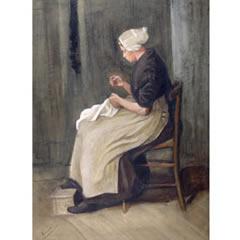 The
Hague School and Young Van Gogh
The
Hague School and Young Van Gogh
Vincent
van Gogh, Woman Grieving (Sientje), 1881-83, ink and pencil on paper,
58 x 42 cm., collection Museum Kröller-Müller
The
world-famous artist Vincent van Gogh is often associated with
sunflowers and France but in fact his artistic roots lay in The Hague
and the painters of the Hague School. This was a group of artists who
were inspired by the French Barbizon School and were innovative in
terms of their realism and interest in the hard lives of labourers
and fisher folk. It was in this artistic environment that the young
Van Gogh developed his own brand of realism and laid the foundations
for his career as a painter.
The Hague School
The
Hague School had a perceptible influence on the life of Vincent van
Gogh even before he decided to become an artist. Coming from a family
of Protestant clergymen and art dealers, Vincent spent some time in
The Hague as a would-be art dealer but found that he was not cut out
for the profession. He moved to Belgium, where he tried to become a
parson, but soon returned to The Hague determined to become a
professional artist. He took lessons from Hague School painter Anton
Mauve (a cousin by marriage), who allowed him to make drawings of
models – often women from Scheveningen – in his studio
and taught him how to go about making a watercolour or a sketch in
oils. Vincent also accompanied Breitner to the waiting room at the
railway station to make sketches of ordinary people and he looked for
suitable models in the old men’s home. However, he was unable
to share in the commercial success of the Hague School painters –
he chose unsaleable subjects and depicted them in a harsh and
unattractive style.
Van
Gogh liked the work of Anton Mauve, H.J. Weissenbruch, Jozef Israëls
and Jacob Maris and the day-to-day life and country scenes that they
recorded in their paintings in subdued colours and loose
brushstrokes. The realism of the Hague School attracted him, but the
dreamy mood of the paintings was often too tame for him. He himself
drew uncompromisingly unpicturesque views of the city and
deliberately sought out the seamier side of life. Where the Hague
School painters gloried in sympathetic depictions of the lives of
peasants and fishermen, Van Gogh wanted to reveal the unpleasantness
of the human condition. The influence of The Hague continued even
after he left the city – still full of his impressions, he
worked on in Drente and Nuenen, where he managed to achieve his
ambitions in various versions of The Potato Eaters, a subject closely
related to those painted by Jozef Israëls (a shining example to
Van Gogh). Right through into his first year in Paris, the influence
of the Hague School can still be detected in the work of Van Gogh and
towards the end of his career he once again embraced tenets of the
artistic philosophy he had absorbed in the city.
With
its great collection of Hague School paintings, the Gemeentemuseum
Den Haag is the ideal place to present the work of the young Van Gogh
in the context of his Hague contemporaries. The exhibition will also
include works from the collections of the Van Gogh Museum, the
Stedelijk Museum Amsterdam, the Kröller-Müller Museum and
other lenders.
Mesdag
and the Hague School
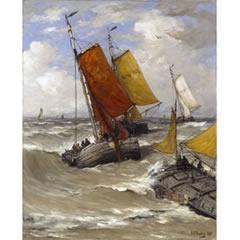 Hendrik
Willem Mesdag (1831-1915) was a leading member of the Hague School
and the only one of that group to specialise in painting seascapes.
As part of the Mesdag Year, this exhibition at the Gemeentemuseum
Den Haag focuses on the greatest ever exponent of Dutch marine
painting. Mesdag was unequalled in his ability to produce
atmospheric canvases depicting changing weather conditions on the
North Sea coast at Scheveningen and the various activities of the
fishing community that lived there. Despite his later fame, Mesdag
was initially regarded by Hague artistic circles as a
well-intentioned amateur; the committee of the Pulchri Studio
artists’ association was even doubtful about admitting him as
a professional member.
Hendrik
Willem Mesdag (1831-1915) was a leading member of the Hague School
and the only one of that group to specialise in painting seascapes.
As part of the Mesdag Year, this exhibition at the Gemeentemuseum
Den Haag focuses on the greatest ever exponent of Dutch marine
painting. Mesdag was unequalled in his ability to produce
atmospheric canvases depicting changing weather conditions on the
North Sea coast at Scheveningen and the various activities of the
fishing community that lived there. Despite his later fame, Mesdag
was initially regarded by Hague artistic circles as a
well-intentioned amateur; the committee of the Pulchri Studio
artists’ association was even doubtful about admitting him as
a professional member.
Gold
medal
Mesdag
was not disheartened. He submitted two paintings for the Paris Salon
of 1870 and astonished everyone by carrying off a gold medal for Les
Brisants de la Mer du Nord
(‘The Breakers of the North Sea’). Mesdag’s mind
was immediately made up: he determined to become a marine painter
and hired a room in Scheveningen overlooking the sea. His seascapes
were soon winning acclaim from leading art critics and Mesdag came
to be regarded as one of the leading artists in a new
“ultra-radical” movement: the Hague School. Mesdag was
also to become a leading light of Pulchri Studio. He co-founded the
Hollandsche
Teeken Maatschappij
(‘Dutch Drawing Society’) – a special water
colourists’ section within Pulchri – and in 1889 he was
elected chairman of Pulchri Studio. He continued to play a prominent
role in the association right through until 1907 and it was partly
due to his efforts and business acumen that Pulchri was able to move
to its present premises in the Lange Voorhout in the course of that
period.
Collector
Mesdag
was also an active collector of work by contemporary artists,
purchasing paintings not only by other members of the Hague School,
but also by Barbizon School artists like Millet, Rousseau and
Daubigny. He also acquired several major works by Courbet. His home
in The Hague (now the Mesdag Museum) was regarded as a shining
example of contemporary good taste, with carpets by Colenbrander,
vases from the Rozenburg pottery and a large collection of Japanese
bronzes.
Panorama
Mesdag
is equally well-known for the largest painting he ever produced: a
1600 m² panorama, painted in 1881 and still on display in its
original rotunda in the Zeestraat (The Hague). His wife, Sientje
Mesdag-van Houten, and his much younger contemporaries Théophile
de Bock, Breitner and Blommers helped in its creation. Mesdag
himself regarded his panorama – a view from the Seinpost Dune
in Scheveningen showing an immense vista of sea, beach, dunes, the
fishing village of Scheveningen and the distant outline of The Hague
– as his most important work. Vincent van Gogh (who attended
the opening) would have heartily concurred. The same themes of the
sea, the beach and the life of local fisherfolk also feature in the
work of the other Hague School painters included in this
presentation, such as Jozef Israëls, Albert Neuhuys, Anton
Mauve, Jacob Maris and J.H. Weissenbruch. The exhibition will
include not only items from the Gemeentemuseum’s own holdings,
but also many works on temporary loan from a private collection.
125th
anniversary programm
In
addition to this exhibition at the Gemeentemuseum, the wide range of
events celebrating the 125th anniversary of the Panorama Mesdag will
include Mesdag exhibitions at the Mesdag Panorama, Mesdag Museum and
Pulchri Studio. See www.mesdag.com
for more of his works.
The
Hague School and the School of Barbizon
Towards
the end of the 19th century, artists turned their backs on history
painting in favour of landscape, previously regarded as an inferior
genre. In France, the Barbizon School emerged as artists began for
the first time to paint outdoors en plein air. This
presentation of work from the museum’s own collections will
show how the painters of Barbizon influenced the Hague School
artists, the former seeking to portray the simple life of the French
countryside and the latter the life of fishing and farming
communities in Holland. Around 1830, artists began making
expeditions from Paris to the forest of Fontainebleau, to work in
the open air and depict nature as it really was. This marked a real
revolution in the thinking of French artists at a time when history
painting was still seen as sacrosanct and the Academy and critical
establishment regarded landscape as a second-rate genre.
Warm grey
The
painters of the new Barbizon School found a warm welcome and
comfortable lodgings at the local inn, the Auberge Ganne, which
quickly became a favourite meeting-place for the avant-garde.
Painters like Millet, Daubigny, Corot and Rousseau applied the new
artistic philosophy in their paintings and drawings. Some artists,
including Millet, Rousseau and Daubigny, actually settled in
Barbizon and Dutch artists like Jozef Israëls and Willem
Roelofs visited the village. The work of the Barbizon School
painters was soon appearing in exhibitions in Brussels. That was
where the young painter Gerard Bilders encountered the “warm
grey” and atmospheric tone of Corot’s landscapes and
where Jozef Israëls found inspiration in Jean-François
Millet’s depictions of peasant life. Hendrik Willem Mesdag
admired Daubigny’s coastal landscapes enough to acquire a
number of them for his famous collection and Troyon’s pictures
of farm animals had an unmistakable influence on the work of Anton
Mauve and Willem Maris. Working en
plein air
also became a tenet of the Hague School; J.H. Weissenbruch, Anton
Mauve and Willem Roelofs worked outdoors in all weathers, in boats
on the inland lakes near Noorden, in the polders around The Hague,
in the dunes, and on the beach at Scheveningen. The Barbizon School
painters greatly admired the realism of the landscapes painted by
the Dutch Old Masters of the seventeenth century and the artists of
the Hague School saw their new approach to landscape painting as
part of the same tradition.
Lithographs
and etchings
The
painters of the Barbizon School were frequently also skilled
engravers. Through lithographs and etchings, their work reached a
wider public and was disseminated via periodicals. This exhibition
will therefore include an important group of French prints from the
collection of the Gemeentemuseum Den Haag, on show to the public for
the first time in many years.
The
Maris Brothers and the Hague School
To
coincide with the exhibition about the Oyens brothers, the
Gemeentemuseum is organising a display of work by the Maris
brothers. The presentation will show that each of the three –
Jacob Maris (1837 – 1917), Matthijs Maris (1839 – 1917)
and Willem Maris (1844 – 1910) – occupied his own
distinctive niche within the Hague School. Jacob became famous for
his landscapes and views of towns, Matthijs’s style can be
described as visionary and imaginative, and Willem achieved success
chiefly with his polder landscapes featuring cows and ducks.
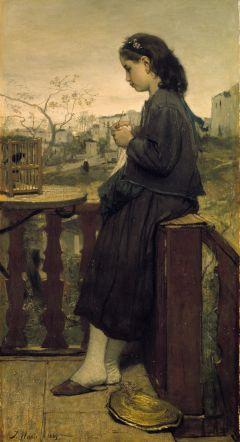 Jacob
Maris
Jacob
Maris
Jacob
Maris was a founder member of the Hague School. He was inspired
initially by the German Romantic illustrator Ludwig Richter. Later
he became interested in the revolutionary ideas of the artists of
the Barbizon School, who believed in working directly from nature
and wherever possible “en plein air” (in the open air).
Jacob Maris adopted their philosophy and worked in the woods around
Oosterbeek, where artists like Gerard Bilders and Anton Mauve were
also setting up their easels. In 1864 he moved to Paris to further
his career. He made oil sketches of rocky landscapes in the area
around Barbizon and produced work for Parisian art dealers Goupil.
‘The Little Knitter’ is a typical example of a Salon
painting from this period. Following the Franco-Prussian war of
1870, Jacob returned to The Hague, where he became a leading figure
in the Hague School that began to emerge in around 1875. He turned
to painting typical Dutch landscapes and views of Dutch towns, with
an emphasis on the atmospheric effects produced by cloudy skies.
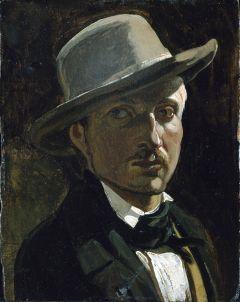
Matthijs
Maris
Like
Jacob, the young Matthijs Maris was interested in Romantic subjects.
He remained true to that movement while studying in Antwerp but in
the 1860s he followed Jacob to Oosterbeek – the ‘Dutch
Barbizon’, as it was sometimes called. In 1861 he travelled to
Germany and to Switzerland, where his visit to Lausanne, on Lake
Geneva, made a particularly deep impression on him. Matthijs was a
visionary who felt that imagination was more important than
recording the real world. In 1869 he too moved to Paris, where his
brother had by then made a name for himself. Unlike Jacob, Matthijs
never returned to the Netherlands. He stayed on in France and
developed a style increasingly divergent from that of the Hague
School. His final years were spent in London, living as an eccentric
recluse, supported by his art dealer, Van Wisselingh.
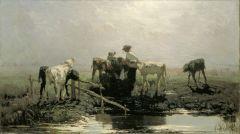 Willem
Maris
Willem
Maris
Willem
Maris was taught by his elder brothers and took evening classes at
the Hague Academy. In Oosterbeek he became friendly with Anton
Mauve. Although he travelled with Blommers to Germany and Norway,
Willem lived all his life in the Netherlands and devoted himself to
sunny polder landscapes featuring cows and ducks. His work had a
strong international following. His pupils included Poggenbeek and
Breitner.
All three Maris
brothers were gifted draughtsmen and water colourists and
contributed to the success of the ‘Hollandse Teeken
Maatschappij’ (the local water colourists’ association)
and the Pulchri Studio artists’ club in The Hague.
The
Hague School Revealed
The Hague School
artists were fascinated by the lives of the labouring classes. For
example, Anton Mauve’s 1882 painting Fishing Boat on the Beach
shows fishermen using horses to drag their boat up the beach in the
absence of a proper harbour. The sea plays an important but
ambiguous role as both a friendly and a hostile force, taking life
but at the same time saving it by providing an income for the
poverty-stricken fishing community.
The Hague School
flourished at a time when people in Europe were, for the first time,
seeking images of national unity. Previously, people in the
Netherlands had thought mainly in terms of their own locality. Now
that the concept of the nation was being emphasised, there was a
need for a unifying idea of national character. Dutch people saw
themselves as indomitable, down-to-earth and hard-working –
like the figures shown in the art of the period.
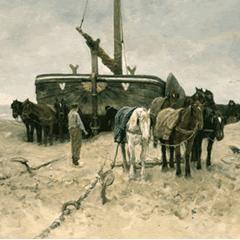
Anton
Mauve (1838-1888) was a leading member of the Hague School and
gave lessons to Vincent van Gogh. Mauve was regarded as a master in
the portrayal of the silvery grey light and hues of the Dutch
landscape. He liked to work in the immediate surroundings of The
Hague: on the beach at Scheveningen, around the flat-bottomed
fishing boats and the fish market, in the dunes, and in the open
fields of the polder. He was also a talented draughtsman and water
colourist and worked in his youth with Willem Maris. In later life,
he withdrew from the artistic world of The Hague and went to live in
Laren. His later works depict the nearby heath with its flocks of
sheep and their attendant shepherds in a wide range of weather
conditions.
Fishing Boat on
the Shore, oil on canvas, 115 x 172 cm (Coll. Gemeentemuseum Den
Haag)
20
September 2008 - 8 February 2009
Jozef
Israëls was already a celebrated and popular painter of the
Hague School when his son Isaac was born. Isaac’s talent
emerged at an early age and it is not surprising that he followed in
his father’s footsteps. But he found the traditional painters’
milieu stifling. He moved from The Hague to Amsterdam, and began to
paint in a completely different style to his father, indeed he is
known as ‘the Dutch impressionist’. That a father and
son can be so similar yet so different is the theme of an exhibition
entitled Jozef and Isaac Israëls, Father and Son, to be held at
the Gemeentemuseum Den Haag.
The Israëls
family originally came from Groningen. Jozef was born there in 1824
in a family with a great interest in religion and art. His
exceptional talent as a painter was obvious from an early age.
Although his first successes were historical works, he came to
specialise in paintings of fishermen and these were the works that
made him world famous. Jozef triumphed in the salons of Brussels and
Paris and he became very prosperous, partly due to the business
acumen of his wife Aleida.
In 1865 his son Isaac
was born. Shortly after the family settled in The Hague. Jozef sent
his talented son to the Drawing Academy but he was not a dedicated
pupil, preferring to go his own way. From very early on he also
wanted to distinguish himself from his father and the sentiments
evoked in the paintings that had made the older Israëls so
popular. His mother Aleida concluded that her son had lost his mind,
expressing her concerns in a letter to her friend Frederik van
Eeden, writer and psychologist. His advice was down-to-earth: ‘Do
you really think that an outstanding artist like your son will be
lost to us if he has to spend some of his youth brooding and
searching for a direction in life?’.
That search led Isaac
to Amsterdam, where he developed into a painter of modern life,
whose fluid brushstrokes earned him the nickname of ‘the Dutch
impressionist’. The difference between Isaac and his father is
clear not only from the style but also from the choice of subject:
no sentimental representations of dramatic emotions, but a swiftly
painted realism. It was perhaps Jozef who expressed the difference
most clearly when he wrote that his son painted soldiers on their
way to the battlefield, while he himself portrayed their weeping
widows. But even when the subject is more light-hearted, the father
and son can never be confused with each other. While Jozef Israëls
painted fisherwomen and their children against the background of
Scheveningen’s seashore and dunes, Isaac portrayed elegantly
dressed ladies in summer costumes in the city, and later bathers on
the Lido in Venice or the fashionable beach of Viareggio.
The exhibition
focuses on the development of the two painters. It also shows how
despite the differences between Isaac’s style and that of his
father, he nevertheless built on the lessons he learned from Jozef.
The rooms of the museum are filled with the monumental, emotional
works of the father, and the fresh, luminous paintings of the son.
 Romanticism
and the Hague School
Romanticism
and the Hague School The
Hague School and Young Van Gogh
The
Hague School and Young Van Gogh Hendrik
Willem Mesdag (1831-1915) was a leading member of the Hague School
and the only one of that group to specialise in painting seascapes.
As part of the Mesdag Year, this exhibition at the Gemeentemuseum
Den Haag focuses on the greatest ever exponent of Dutch marine
painting. Mesdag was unequalled in his ability to produce
atmospheric canvases depicting changing weather conditions on the
North Sea coast at Scheveningen and the various activities of the
fishing community that lived there. Despite his later fame, Mesdag
was initially regarded by Hague artistic circles as a
well-intentioned amateur; the committee of the Pulchri Studio
artists’ association was even doubtful about admitting him as
a professional member.
Hendrik
Willem Mesdag (1831-1915) was a leading member of the Hague School
and the only one of that group to specialise in painting seascapes.
As part of the Mesdag Year, this exhibition at the Gemeentemuseum
Den Haag focuses on the greatest ever exponent of Dutch marine
painting. Mesdag was unequalled in his ability to produce
atmospheric canvases depicting changing weather conditions on the
North Sea coast at Scheveningen and the various activities of the
fishing community that lived there. Despite his later fame, Mesdag
was initially regarded by Hague artistic circles as a
well-intentioned amateur; the committee of the Pulchri Studio
artists’ association was even doubtful about admitting him as
a professional member.
 Jacob
Maris
Jacob
Maris 
 Willem
Maris
Willem
Maris